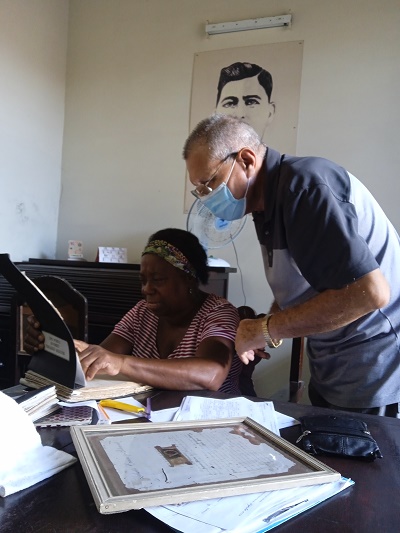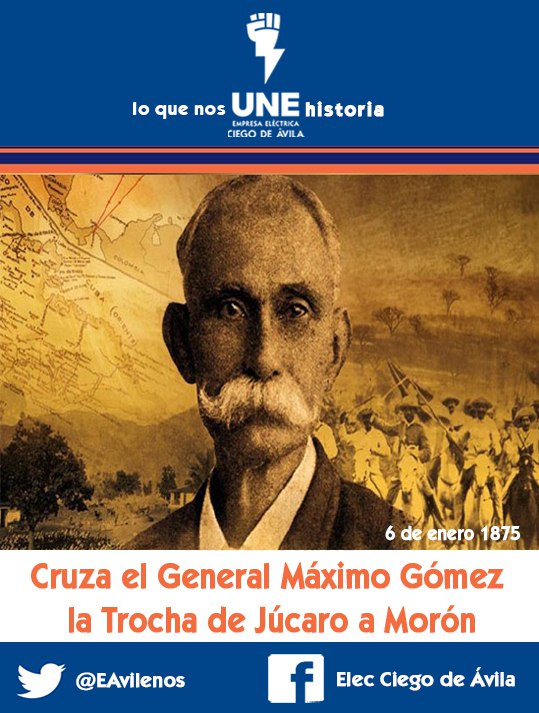
Time erased the colors. Looking at that little piece that holds so much history is overwhelming in a certain way and motivates the most dissimilar questions. Well, that little piece of fabric barely 40 millimeters at the top, 35 at the bottom and 25 high belongs to the shirt that Antonio Maceo y Grajales wore on the day he fell in combat on December 7, 1896 in the fields of San Pedro.
"It is a true relic and with tremendous value for Cuba," José Luis León Hidalgo, a museologist at the Coronel Simón Reyes Hernández Provincial History Museum, in Ciego de Ávila, where the piece is kept, says.
However, how did that piece get to the institution? Who were its owners and how did they get it? Nevertheless, in addition, what information supports its authenticity?
BEFORE THE HEROES
While reviewing the documentation, Elsa Viol Cárdenas, Simón Reyes Hernández's museologist, states that the object was obtained by the Provincial Heritage Department through a purchase from the Arredondo Miranda family on June 30, 1993.
Other data are revealing its authenticity. The fragment is embedded in a small Cuban flag; which, in turn, is inserted into a document describing its origin and signed by the person who made the original donation: Salvador Cisneros Betancourt, the president of the Republic of Cuba in Arms.

Elsa Viol Cárdenas and José Luis León Hidalgo, specialists from the Simón Reyes Museum, review the documentation on the fragment of Maceo's shirt. Photo: Luis Raúl Vázquez Muñoz
In one of its paragraphs, it reads in print:
«On the day of the exhumation of such precious remains, on September 17, 1899, rests of the shirt were found with them; and a small part of this, to which the one that I accompany here belongs, was dedicated and delivered to me right there, as specified in the record for that purpose, by the Notary Mr. Gaspar Barona ».
Later, he declares:
«And I, to prove the authenticity of this Memory, sign this document with my own hand in “El Cacahual”, in the burning chapel where I make honor guard to the mortal remains of those heroes, on September 19, 1899».
Next, some strokes are almost illegible due to time, although they are still capable of showing the careful calligraphy of one of the great Cuban patriots.
THE COLORS OF SAN PEDRO
The document testifies that the shirt was blue. However, today that color has turned into a grayish shade. Some darker tones invite us to think about the colors acquired when the fragment was watered with Maceo's blood. It is known that the death of the Bronze Titan occurred at a time when the rebels were cutting a fence to make a cavalry charge.
His death caused a rout. When Commander Juan Manuel Sánchez was leaving through the gate where Maceo entered, he ran into Captain Francisco (Panchito) Gómez Toro, son of Generalissimo Máximo Gómez Báez.

Asking him where he was going, he heard: "To die next to the general." Panchito should not fight. By direct orders of the Titan, he had to remain in the camp, since he was convalescing from a wound received in the shoulder during the combat of La Gobernadora or Vejerano in Pinar del Río, on December 3, 1896.
For that reason, he had his arm in a sling, which made it impossible for him to move his 220-pound body in the middle of a hail of shots.
There, he received two bullet wounds, tried to commit suicide with a knife and was finished off with a machete by the guerrilla of Canarian origin Juan Santana Torres, from the San Quintín Battalion, according to the historian Francisco Pérez Guzmán in his book La guerra en Havana.
THE FOOTPRINTS OF THE TITAN
In his excellent report, The General's Last Vestment, by journalist Dariel Pradas, the main specialist of the Historical Archive of the Havana Historian's Office, Alexis Placencia, assures that in the country there are at least three copies similar to the piece kept by the museum in Ciego de Ávila.
One is kept in the National Archive of Cuba, another in the Museum of the Revolution and a third in the Office of the Historian of Havana. According to the statements, all these pieces are accompanied by a certificate issued by Salvador Cisneros Betancourt.
José Luis León, for his part, mentions the existence of another remains of the shirt in the Bacardí Museum in Santiago de Cuba, supported by the information provided in the book Approaches to the Maceos, coordinated by professors Olga Portuondo Zúñiga, Israel Escalona Chávez and Manuel Fernandez Carcases.
Whether or not this last piece belonged to Cisneros Betancourt is something to specify, together with the people or institutions to which the rebel president decided to donate parts of such a significant garment.
In the case of the fragment from Ciego de Avila, the historian José Martín Suárez Álvarez was able to specify several details from the heading of the certificate, where the Marquis of Santa Lucía states that he delivers the souvenir to the Camagüey newspaper El Cuje, which he names "Champion of Independent Cuba".
Martín Suárez points out in an article published on the Cubarte portal, that this newspaper was founded and administered by the officer of the Liberation Army Gaspar Arredondo y Miranda, who held positions in the government of the Republic of Cuba in Arms.
By the end of the 19th century, the Arredondo Miranda family was recognized for its independence work, since Gaspar's brother, Tomás, had also been a rebel and representative of the Cuban Revolutionary Party in Venezuela.
Perhaps the main element that motivated Cisneros's compliment was the work of denouncing El Cuje against the US intervention in Cuba.
According to an article published in the newspaper Invasor, the journalist and historian José Antonio Quintana García emphasizes, based on the information contained in the book “La prensa camagüeyana del siglo XIX”, by the researcher Eduardo Labrada, that El Cuje openly confronted the US occupation and with a force that inspired other publications.
It is presumed the origin of the qualification of Champion of Cuba made by Salvador Cisneros when he issued the certificate in 1899 from that fact.
Thus, a few years later, in 1905, Gaspar Arredondo y Miranda arrived at a village located 110 kilometers from the city of Camagüey, which by then was changing its appearance rapidly with the dizzying construction of power stations and railway lines.
There, he would found the newspaper El Pueblo. In their suitcases, in a box with beige frames, one of the most sublime objects in the history of Cuba also arrived in Ciego de Ávila: a fragment of Antonio Maceo's shirt.
